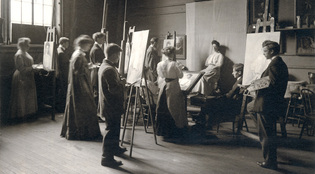 loading
loading
Old YaleThe first female students at YaleJudith Ann Schiff is chief research archivist at the Yale University Library.  Manuscripts & ArchivesA coeducational painting studio around the turn of the century. Women made up the majority of students at the art school during its first four decades. View full imageThis fall marks the 40th year of coeducation in Yale College. It is also the 140th anniversary of a much older coeducation milestone: the year Yale University admitted its first female students. Yale opened its School of the Fine Arts, the nation's first university arts school, in 1869. In accordance with the wishes of its funders, the school included women from the start. Augustus Street ’12 had studied law but never practiced, due to poor health. As the only son of a successful New Haven businessman, however, he inherited considerable wealth. He and his wife, Caroline Leffingwell Street, gave about $400,000 to Yale in all, including an endowment of $117,000 for the new school and some $200,000 to construct its home, the Art Building (later named Street Hall). The couple had seven daughters, all of whom died young. This family history may have been one reason why Street specified in his will that the new institution was to be “a school for practical instruction, open to both sexes, for such as propose to follow art as a profession.” Street also wanted the school “to awaken and cultivate a taste for the Fine Arts among the undergraduates and others.” In its first year the school had three students. Two were women -- Alice and Susan Silliman, daughters of chemistry professor Benjamin Silliman Jr. ’37. For the next four decades, the majority of the art school's students were women. The first person to earn a bachelor of fine arts degree at Yale, in 1891, was also a woman. Originally, the School of the Fine Arts awarded only a certificate for completion of its full three-year course. But in 1874 Syracuse University offered the nation's first BFA, and in 1891 Yale's governing board, the Corporation, established a BFA degree. Candidates had to take two years' worth of advanced studies beyond the three-year certificate and submit both a written thesis and original work in painting or sculpture. The degree was intended, the Corporation specified, only for “students who have made special attainments and have given evidence of marked ability in their work.” The founding dean of the school, John F. Weir (who served until 1913), treated the BFA almost like an honorary degree. “One could not register for it or get it in course,” stated drawing instructor George H. Langzettel, who had received his own BFA in 1898. Rather, Dean Weir “kept in touch with the record of students after they had become professionals, and then invited them to receive it.” Painter Josephine Miles Lewis (1865-1959), recipient of Yale's first BFA, was the daughter of the mayor of New Haven. (Hers was the second degree Yale conferred on a woman; the first was Alice Rufie Jordan Blake's bachelor of laws, 1886.) Lewis had studied at the school since 1883 and received her certificate in 1887. The year after earning her BFA, she traveled to Europe, where she studied for five years with the Impressionists in Paris and the south of France. In 1897 her work was included in the prestigious Paris Salon. After returning to the United States, Lewis opened a studio in New York City. In 1916, the National Academy of Design awarded a prize for her painting A Rainy Day, rating it “the most meritorious art produced by an American woman.” She never married, and she kept painting all her life. Her New York Times obituary called her a “portrait painter of children, exhibited here and abroad.” Other women, like Annie S. Johnson (1853-1937), won recognition only posthumously, after society's perception of female artists had changed. But in recent times, the number of prominent female artists from the Yale School of Art has multiplied, with some, such as Sylvia Mangold ’61BFA, Eva Hesse ’59BFA, and Howardena Pindell ’67MFA, achieving renown. Further, all of Yale's other schools have long since followed the School of Art's lead on the education of women -- another successful legacy, one might argue, of Augustus and Caroline Street.
The comment period has expired.
|
|